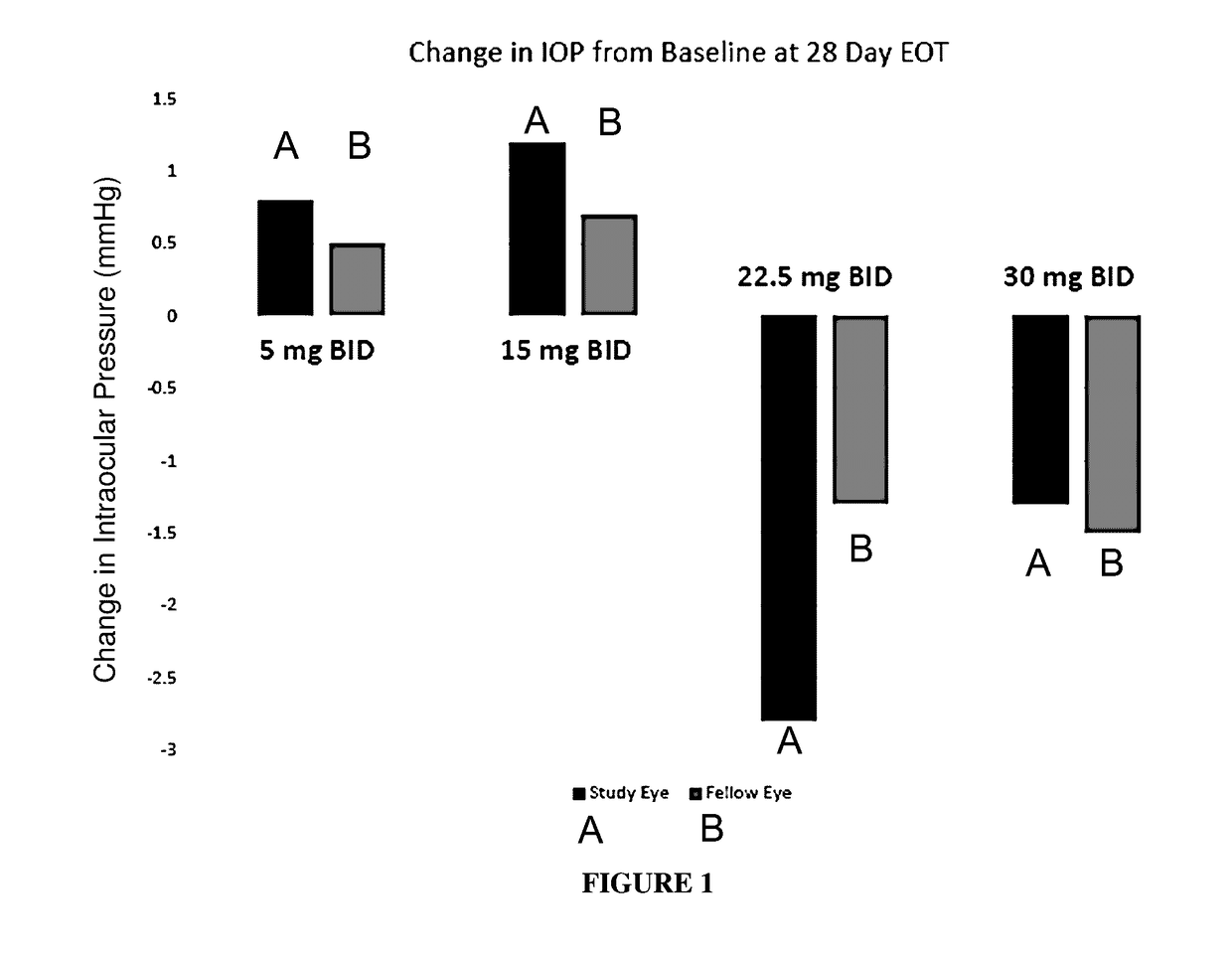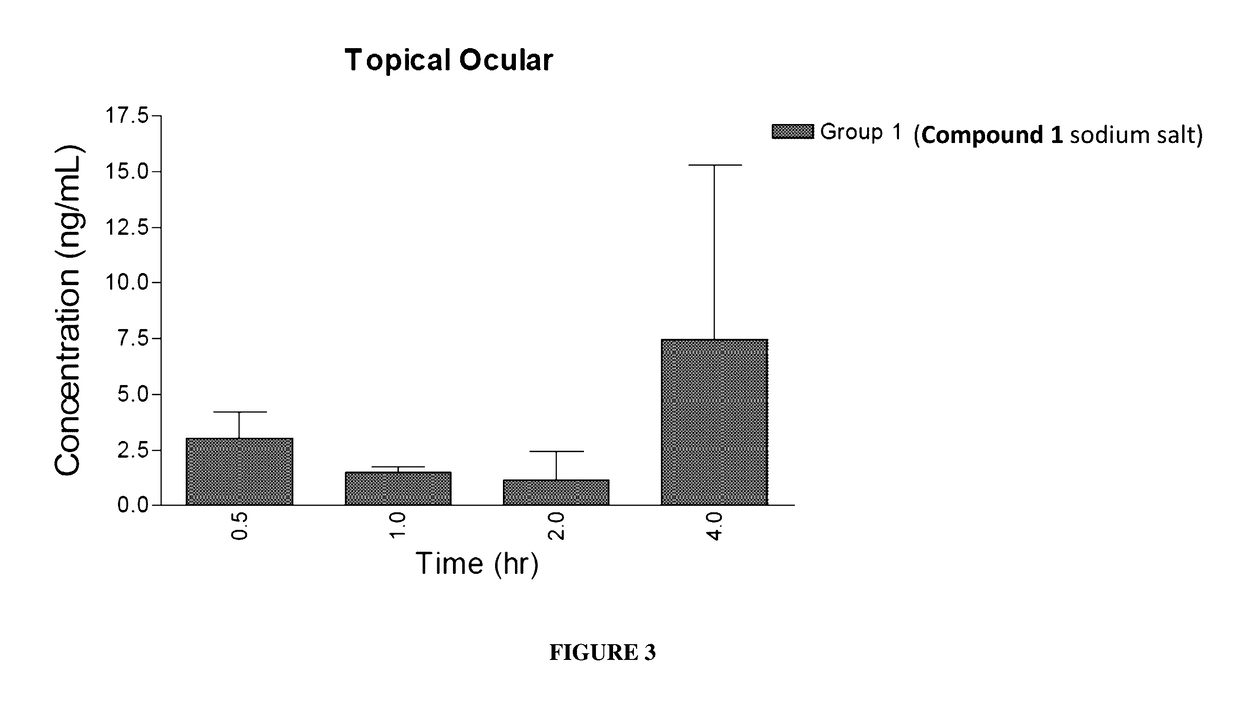Methods of treating intraocular pressure with activators of tie-2
a technology of activators and intraocular pressure, which is applied in the direction of sense disorder, organic active ingredients, drug compositions, etc., can solve the problems of ocular hypertension, increased risk of glaucoma, and damage to the optic nerve, so as to and reduce the intraocular pressure
- Summary
- Abstract
- Description
- Claims
- Application Information
AI Technical Summary
Benefits of technology
Problems solved by technology
Method used
Image
Examples
example 1
Compounds with Inhibitory Activity to HPTP-β
[0149]Non-limiting examples of the HPTP-β IC50 (μM) activity for illustrative compounds are listed in TABLE 2.
TABLE 2HPTP-βNo.CompoundIC50 μMAA10.000157(S)-{4-[2-(4-Ethylthiazol-2-yl)-2-(phenylacetylamino)ethyl]-phenyl}sulfamic acidAA20.0044-{(S)-2-[(R)-2-(tert-butoxycarbonylamino)-3-phenylpropanamido]-2-(4-ethylthiazol-2-yl)ethyl}phenylsulfamic acidAA30.031{1-[1-(5-Ethylthiazol-2-yl)-(S)-2-(4-sulfoaminophenyl)ethyl-carbamoyl]-(S)-2-phenylethyl}methyl carbamic acid tert-butyl esterAA4−8{1-[1-(5-phenylthiazol-2-yl)-(S)-2-(4-sulfoaminophenyl)ethylcarbamoyl]-(S)-2-phenylethyl}methyl carbamic acid tert-butyl esterAA5−84-{(S)-2-(S)-2-(tert-Butoxycarbonylamino)-3-phenylpropanamido-2-(2-phenylthiazol-4-yl)}phenylsulfamic acidAA60.0001624-{(S)-2-(4-Ethylthiazol-2-yl)-2-[(S)-2-(methoxycarbonylamino)-3-phenylpropanamido]ethyl}phenylsulfamic acidAA70.0064-{(S)-2-[(S)-2-(Methoxycarbonylamino)-3-phenylpropanamido]-2-(thiazol-2-yl)ethyl}phenylsulfamic a...
example 2
Ocular Pharmacokinetics After Administration of Compound 1
[0150]To measure the concentration of Compound 1 in plasma and ocular tissues following topical ocular, subcutaneous, and intravitreal administration, New Zealand White rabbits were administered Compound 1, and plasma and ocular samples were collected at pre-determined time points. Compound 1 formulations were prepared fresh on each day of dosing.
[0151]Ocular tissue samples from both eyes of each animal were collected and weights were recorded. Plasma and ocular tissue sample concentrations of Compound 1 were determined by LC-MS / MS.
[0152]New Zealand White rabbits weighing 2.5 to 3.5 kg were used on this study. Rabbits were housed one per cage. Animals were not fasted and only healthy animals with no ocular illness were used. Two rabbits per group were sacrificed at each of four ocular tissue sampling time points for a total of eight rabbits per group. The study design is presented in TABLE 3 and TABLE 4.
[0153]Animals were ane...
example 3
Tolerability and Effect on Intraocular Pressure of Compound 1 (Sodium Salt) Following Repeated Topical and Subcutaneous Administration
[0181]To measure the tolerability and effect of Compound 1 (sodium salt) on intraocular pressure following repeated topical and subcutaneous administration, normotensive New Zealand White rabbits were treated with Compound 1 (sodium salt).
[0182]Prior to treatment initiation, selection of animals for the study was based on a visual appraisal of good clinical condition and body weight specifications. All animals were healthy at the time of animal selection. Animals selected for use in this study were as uniform in age and weight as possible. The animals were housed in individual cages within the same room during the study. No other species were housed in the same room. The room was well ventilated (greater than 10 air changes per hour) with at least 60% fresh air. A 12-hour light / 12-hour dark photoperiod was maintained, except when rooms were illuminate...
PUM
| Property | Measurement | Unit |
|---|---|---|
| Pressure | aaaaa | aaaaa |
| Pressure | aaaaa | aaaaa |
| Pressure | aaaaa | aaaaa |
Abstract
Description
Claims
Application Information
 Login to View More
Login to View More - R&D
- Intellectual Property
- Life Sciences
- Materials
- Tech Scout
- Unparalleled Data Quality
- Higher Quality Content
- 60% Fewer Hallucinations
Browse by: Latest US Patents, China's latest patents, Technical Efficacy Thesaurus, Application Domain, Technology Topic, Popular Technical Reports.
© 2025 PatSnap. All rights reserved.Legal|Privacy policy|Modern Slavery Act Transparency Statement|Sitemap|About US| Contact US: help@patsnap.com



